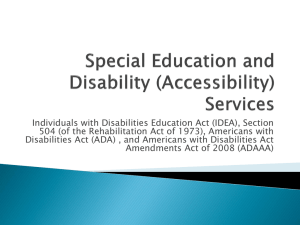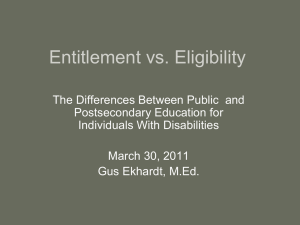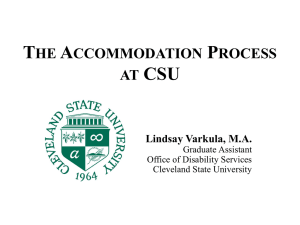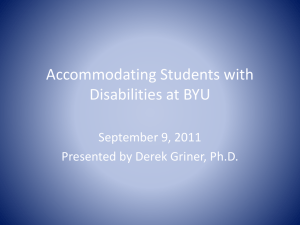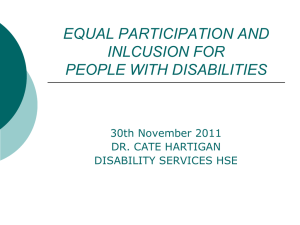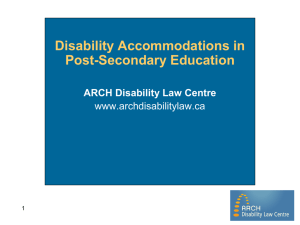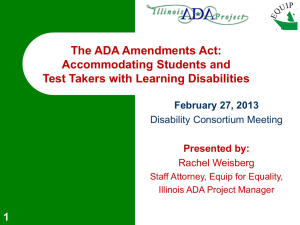Preparation, accommodations and support for
advertisement
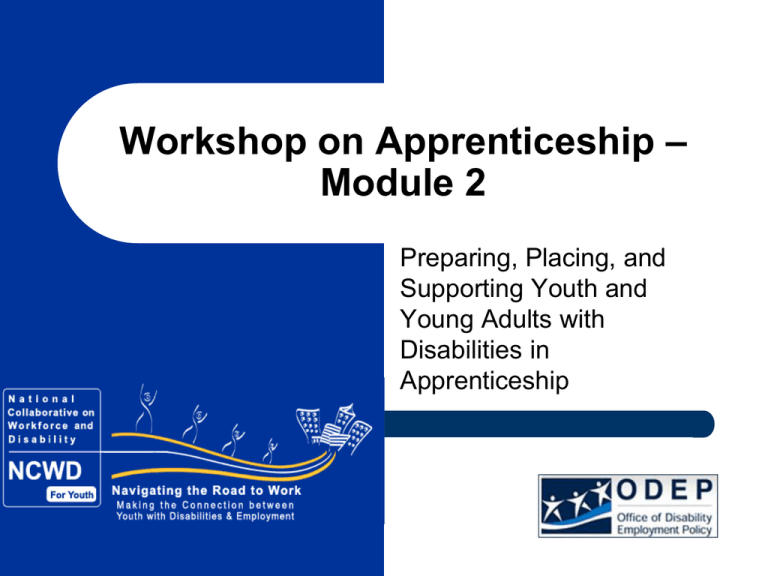
Workshop on Apprenticeship – Module 2 Preparing, Placing, and Supporting Youth and Young Adults with Disabilities in Apprenticeship Objectives 2 Understand entry requirements Review options for preparing youth/young adults Understand legal requirements, accommodations and support for youth with disabilities Why Focus on Youth and Young Adults with Disabilities? 3 More than 22 million people ages 21 to 64 have a reported disability Incidence is particularly high for system involved youth – juvenile justice and foster care 30-40% of children in foster care are also in special education Mental health issues are more prevalent among these groups Facts and Stats (continued) 4 10% - 12% of youth will have a mental health problem that requires short-term treatment Over 50% of youth with mental health needs will drop out of school; only 5% - 20% will enter postsecondary education 5% of school children have some form of a learning disability and are served under special education, while 15% - 17% have reading difficulties; less than 8% go on to college Two-thirds of those with learning disabilities have not been identified by the school system Facts and Stats (continued) 5 So-called “hidden disabilities” represent 60 – 70% of all disabilities Over half of students in special education have a specific learning disability Myths around disabilities and accommodations abound Instructional approaches to supporting people with disabilities tend to benefit all learners Entry Requirements for Apprenticeship Programs 6 Spelled out in program standards Typically must be at least 18 years of age High school diploma or G.E.D. Able to perform the essential functions, with or without accommodations Aptitude for occupation Clean drug test Youth and Young Adults in Apprenticeship Average apprentice age is 30 years old Youth and young adults ages 16 – 23 make up: – – – – 7 50% of electricians 47% of bricklayers 47% of carpenters 44% of painters Steps to Preparation 8 Assessment of interests, skills, and abilities Completion of high school education Enrollment in preparatory program Pre-apprenticeship, school-toapprenticeship, youth apprenticeship, and other feeder programs. Assessment 9 Typical areas: academic performance/achievement, vocational interests, job aptitudes/skills, cognitive abilities, physical, and functional capacities Myriad of resources and assessment instruments available, including “Career Planning Begins with Assessment” Do not forget basic interviewing as an assessment tool Preparation for Apprenticeship 10 Gateway programs include school-to-apprenticeship, youth apprenticeship, and pre-apprenticeship programs Programs operate in some but not all states – most prevalent in Ohio, Washington, and Wisconsin Other opportunities for both in-school and out-ofschool youth What is Available in Your Area? 11 One-stop career center Local school district Local community college Apprenticeship training representative YouthBuild --- www.youthbuild.org Job Corps – www.jobcorps.gov Supporting Youth in the Classroom and in the Workplace 12 Understanding the definition of disability Understanding the legal requirements Learning about accommodations Understanding the principle of universal design Definition of Disability 13 American with Disabilities Act (ADA), which was amended in 2008, applies to employment, transportation, public accommodations, and activities of state and local government, includes public and private sector employment/training programs ADA provides broadest definition: – A person who has a physical or mental impairment that substantially limits one or more major life activities – A person who has a history or record of such an impairment – A person who is perceived by others as having such an impairment Requirements for the Workplace, Classroom, and Service Providers 14 Individuals with Disabilities Education Act (IDEA) applies to public schools receiving federal funds Sections 504 of the Vocational Rehabilitation Act apples to programs that receive federal funds Title I of the Vocational Rehabilitation Act spells out program eligibility Basic Requirements 15 Varies from Act to Act Common themes: – Prohibition against discrimination based on disability – Requirements for accommodations – Intent is for full inclusion of people with disabilities in all aspects of society, including the classroom and the workplace Definition of Accommodations 16 Changes made in an educational setting, work site, assessment procedures or service delivery procedure that help people with disabilities learn, work or receive services Not about lowering performance expectations in school or worksite – Does lessen the impact of the environment on the disability Typical Accommodations 17 Are tailored to the environment – i.e., classroom or work place Involve presentation/understanding of materials and directions Use of tools/equipment, including adaptive technology Changes to physical environment for accessibility Workplace Accommodations 18 Governed by ADA Applies to businesses of 15 or more Introduces key terminology: – Qualified persons with a disability – Essential job functions – Reasonable accommodations – Undue Hardship Review of ADA Terminology Qualified person with a disability is an individual with a disability who can: Satisfy the required skills, experience, and education for the position Perform the essential functions, with or without reasonable accommodations Essential Job Functions are tasks that fundamental and necessary to perform a given position; they do not include marginal duties 19 Review (continued) 20 “Reasonable” accommodations are any change an employer makes that enables a qualified person with a disability to: – Have equal opportunity in the selection process – Perform the essential functions – Enjoy equal benefits and privileges of employment Undue Hardship Considerations 21 Accommodations that would require significant difficulty or expense based on: – Size of business operation – Financial resources of employer – The disruption to other workers – Significant alteration to the employer’s business or changes in the delivery of services Scenarios – What Would You Do? 22 A customer service rep for a financial institution lost his vision and could no longer read his computer screen A medical transcriptionist was injured and became paraplegic A CAD/CAM drafting specialist became quadriplegic and had limited use of extremities Scenarios (continued) 23 An employee who works in a manufacturing environment had a learning disability. The employee had difficulty remembering task sequences of the job A saw operator with a learning disability had trouble measuring to the fraction of an inch Disclosure and Accommodations 24 Disclosure of disability is voluntary In employment situations, it is up to the individual to disclose disability/request accommodations as there are restrictions on questions around disabilities In a classroom/program setting, it is important to encourage individuals to disclose to ensure adequate supports Dos and Don’ts 25 Employers may not ask specific disability questions in the interview process, but may ask generally about physical ability to do the work – e.g., job requires lifting 50 pounds May ask disability-related questions in both postoffer stage and after individual begins work Post-offer questions must be the same for all All information must be kept confidential Universal Design 26 Universal Design (also called universal access) is the design of environments, products, communication, as well as the delivery of programs, services, and activities to be useable to the greatest extent possible by all individuals Applies to learning environments as well as to the workplace Tends to benefit everyone – not just people with disabilities Resources 27 Job Accommodation Network – www.jan.wvu Equal Employment Opportunity Commission – www.eeoc.gov Office of Disability Employment Policy – www.dol.gov/odep Comprehensive disability information – www.disability.gov Resources and information – www.ncwd-youth.info Tips for Successful Placements 28 Follow-up with employer and apprentice to ensure success Ask for feedback on job performance Visit the worksite Resolve small issues before they become big issues
